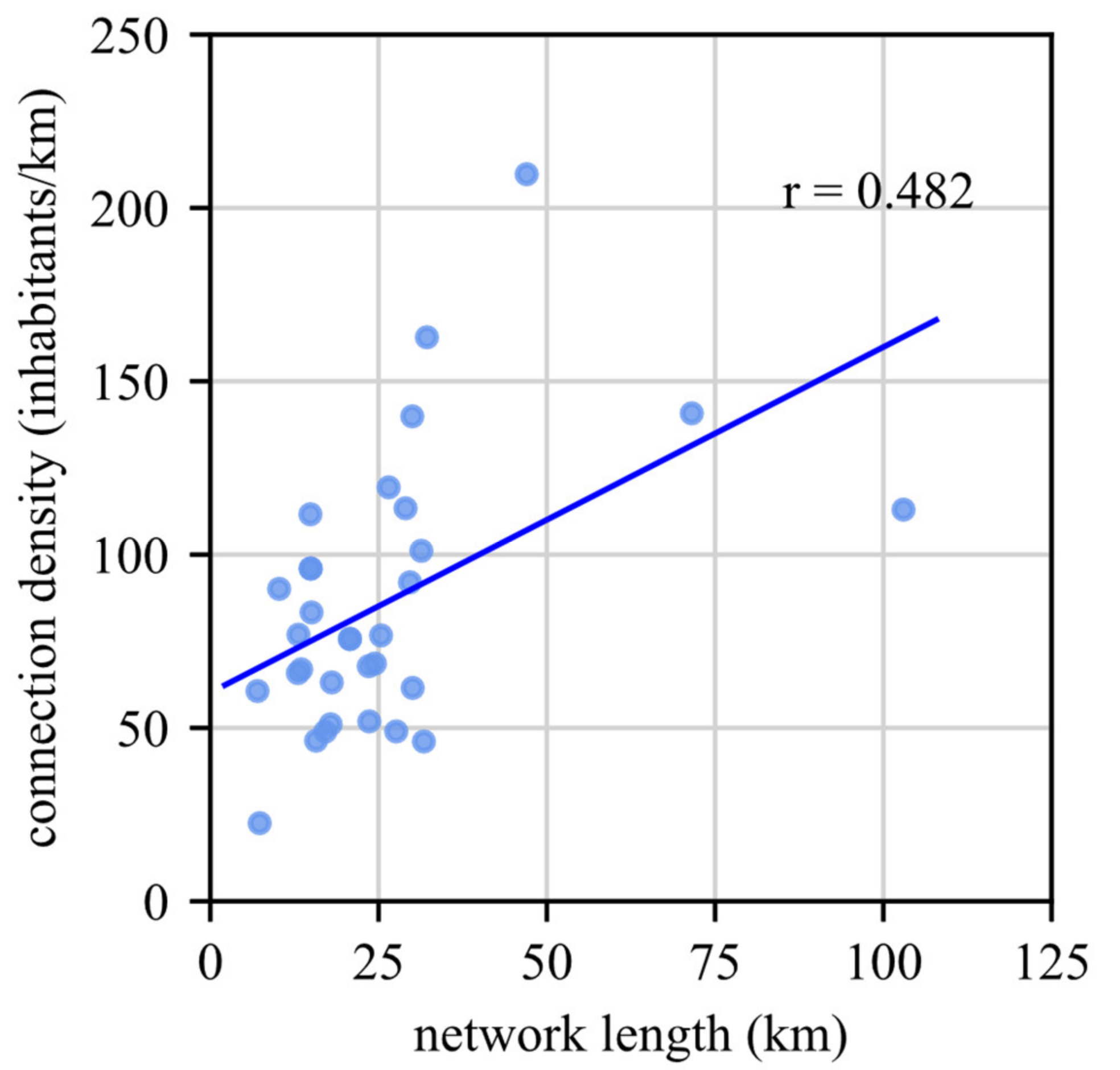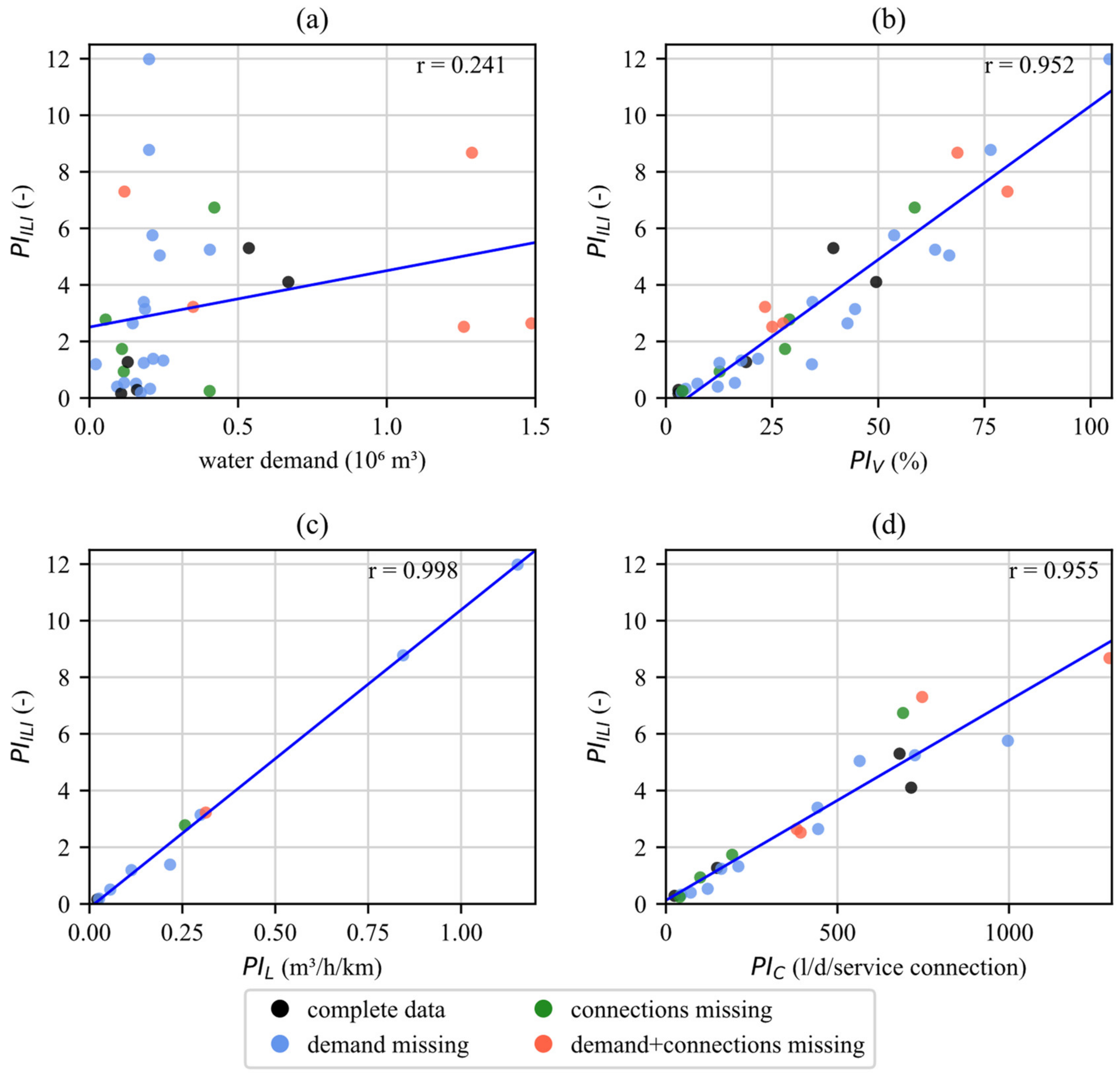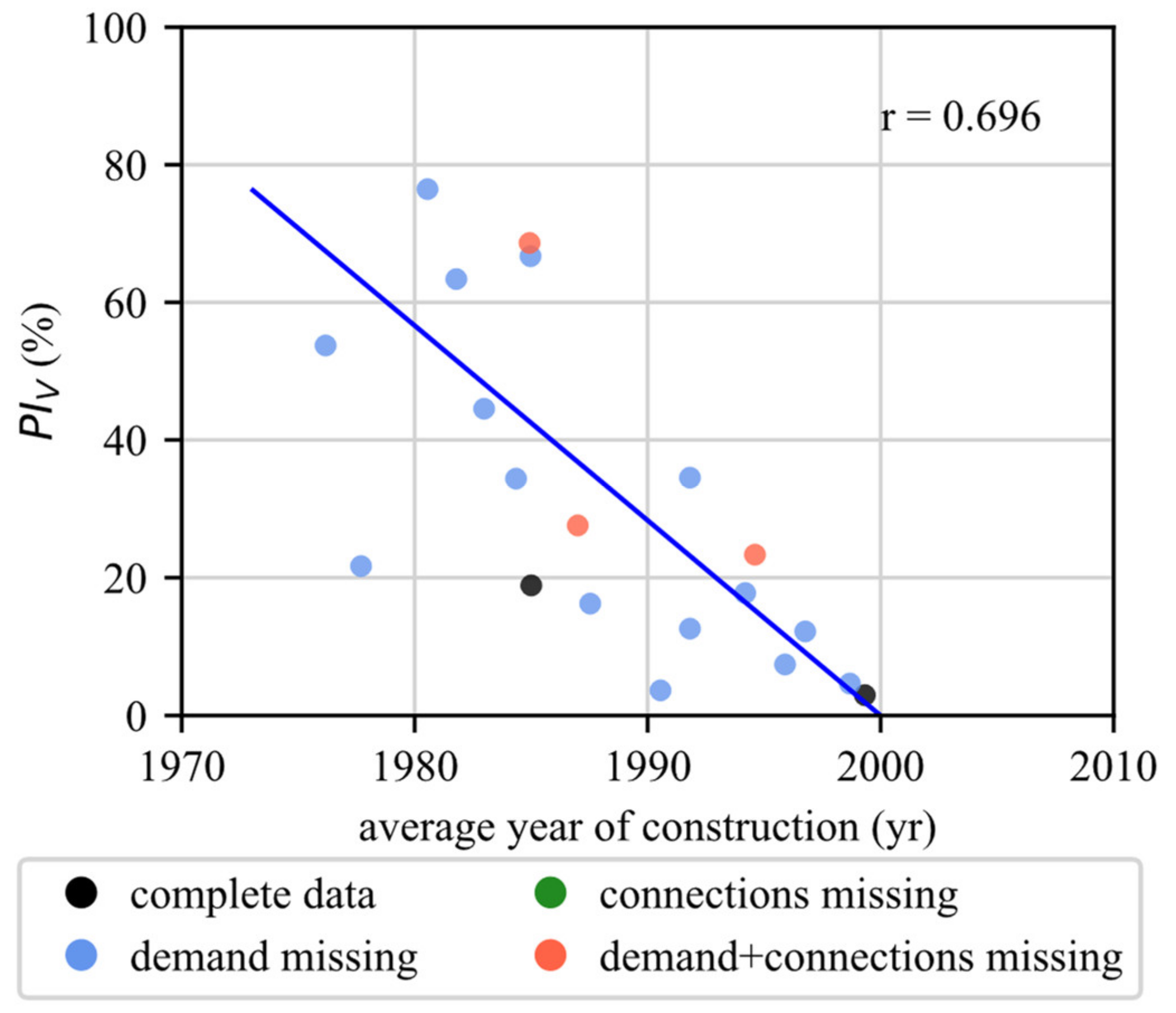Water Loss Management in Small Municipalities: The Situation in Tyrol
Abstract
1. Introduction
- Identify a usable performance indicator (PI) for water loss management that is especially suitable for challenges of very small municipalities.
- Present common sources of water loss in small water distribution networks (WDNs).
- Describe influences of state funding and rehabilitation planning on performance of WDNs (e.g., improving water loss management).
- Discuss additional problems faced by operators of small WDNs.
2. Materials and Methods
2.1. Technical Performance Indicators for WDNs
2.2. Overview of Austrian Standards and State Funding Related to WDNs
2.3. Case Study
2.3.1. Network Characteristics
2.3.2. Missing Data
3. Results and Discussion
3.1. Evaluation of Water Loss Performance
3.2. Identification of Water Losses
3.3. Experiences Regarding Rehabilitation
- Rehabilitation: Although one WDN was very old, it has the lowest PI (PIV is 7%). The initial WDN was constructed in the 1930s with first extensions and then renovations in the 1940s and 1950s, respectively. In the last few years, the network operators have put a lot of effort into renewing the system, reducing both average year of construction (now 1999) and water losses.
- Rehabilitation planning using survival curves: Only one of the investigated WDNs documented repair work due to bursts and leaks in a detailed way such that they could be used for estimating expected service life of pipes with the same construction year. Consequently, rehabilitation planning using survival curves does not provide statistically relevant information for network renewal as the data base is too small in small WDNs.
- On-line hydraulic monitoring: One WDN with less than 1000 connected inhabitants had water losses of 3% of the total water demand. To achieve such a low value, the network operator installed an online monitoring system several years ago. By continuously measuring the system inputs, irregularities and anomalies can be detected, and bursts and leaks can be repaired relatively quickly. In contrast, none of the investigated WDNs used pressure sensors for leakage detection as pressure fluctuation are low due to overdesigned pipes (e.g., regulations about fire flow and minimum pipe diameter) and low water extractions (e.g., distributed system with a low number of connected inhabitants).
- Leakage detection campaigns: Two larger WDNs had a PIV between 20 and 30%, corresponding to a PIILI between 2 and 3, although one of them had a very complex network structure with different pressure zones. To obtain these relatively low levels, leakage detection campaigns were carried out every year to detect failures in the WDNs. As reports from the network operators indicate, lower values of water losses were hard to achieve, but could be maintained through annual inspection. Additionally, repairing bursts and leakages, which are detected by applying leakage detection campaigns, can reduce water losses significantly. For example, a WDN with approximately 1500 inhabitants could reduce water losses from 45 to 7% within two months.
3.4. Additional Problems Faced by Network Operators of Small Municipalities
- Private swimming pools: One of the main stresses affecting small WDNs is the high increase of private swimming pools and the filling of them with drinking water in spring and refilling in summer, which increases required drinking water demand considerably. As mentioned above, online monitoring systems are used to monitor system performance, where an increase of system input can indicate leakages in the system. Therefore, it is difficult to distinguish pool fillings from real leakages, though the period for pool filling can be limited to warm weekends in spring and summer.
- Conflict between settlement expansion and source protection areas: In Tyrol, protection zones have been established for many drinking water sources, in which handling of harmful substances and constructions are restricted. Additionally, settlement area is increasing due to constant expansion. Consequently, an increased potential for conflict between protection of drinking water resources and urban use of the landscape has been identified, and this conflict will increase further in future.
- Limits of harmful substances: At this state of legislation, expansive countermeasures are needed to reduce harmful substances in drinking water. Currently, there is a discussion about decreasing the limits of harmful substances, mainly focusing on arsenic, antimony, and uranium. These substances can be of natural origin (e.g., granite and gneiss are sources of uranium and were common in the case study), but human influences, e.g., contaminated sites in the form of former landfills, can also be identified as possible causes. In this context, this ongoing process may help the water utilities.
4. Summary and Conclusions
Author Contributions
Funding
Conflicts of Interest
References
- Lambert, A.; Hirner, W. Losses from Water Supply Systems: Standard terminology and recommended performance measures. In Blue Pages; International Water Association: London, UK, 2000; Volume 10, pp. 320–338. [Google Scholar]
- Al-Washali, T.; Sharma, S.; Kennedy, M. Methods of assessment of water losses in water supply systems: A review. Water Resour. Manag. 2016, 30, 4985–5001. [Google Scholar] [CrossRef]
- Kingdom, B.; Liemberger, R.; Marin, P. The Challenge of Reducing Nonrevenue (NRW) Water in Developing Countries. How the Private Sector Can Help: A Look at Performance-Based Service Contracting; Technical Report 8; Water Supply and Sanitation Sector Board Discussion Paper Series; The World Bank: Washington, DC, USA, 2006. [Google Scholar]
- EurEau. Europe’s Water in Figures—An Overview of the European Drinking Water and Waste Water Sectors. Available online: http://www.eureau.org/resources/publications/1460-eureau-data-report-2017-1/file (accessed on 3 August 2020).
- Mutikanga, H.; Sharma, S.; Vairavamoorthy, K.; Cabrera, E. Using performance indicators as a water loss management tool in developing countries. J. Water Supply Res. Technol.-Aqua 2010, 59, 471–481. [Google Scholar] [CrossRef]
- EPA. Water Audits and Water Loss Control for Public Water Systems. Available online: https://www.epa.gov/sites/production/files/2015-04/documents/epa816f13002.pdf (accessed on 3 August 2020).
- Colombo, A.F.; Karney, B.W. Energy and costs of leaky pipes: Toward comprehensive picture. J. Water Resour. Plan. Manag. 2002, 128, 441–450. [Google Scholar] [CrossRef]
- Loureiro, D.; Alegre, H.; Silva, M.S.; Ribeiro, R.; Mamade, A.; Poças, A. Implementing tactical plans to improve water-energy loss management. Water Supply 2017, 17, 381–388. [Google Scholar] [CrossRef]
- Zyoud, S.H.; Kaufmann, L.G.; Shaheen, H.; Samhan, S.; Fuchs-Hanusch, D. A framework for water loss management in developing countries under fuzzy environment: Integration of Fuzzy AHP with Fuzzy TOPSIS. Expert Syst. Appl. 2016, 61, 86–105. [Google Scholar] [CrossRef]
- Laureti, T.; Benedetti, I.; Branca, G. Water use efficiency and public goods conservation: A spatial stochastic frontier model applied to irrigation in Southern Italy. Socio-Econ. Plan. Sci. 2020. [Google Scholar] [CrossRef]
- Benedetti, I.; Branca, G.; Zucaro, R. Evaluating input use efficiency in agriculture through a stochastic frontier production: An application on a case study in Apulia (Italy). J. Clean. Prod. 2019, 236. [Google Scholar] [CrossRef]
- Agovino, M.; Cerciello, M.; Gatto, A. Policy efficiency in the field of food sustainability. The adjusted food agriculture and nutrition index. J. Environ. Manag. 2018, 218, 220–233. [Google Scholar] [CrossRef]
- Liemberger, R.; Wyatt, A. Quantifying the global non-revenue water problem. Water Supply 2019, 19, 831–837. [Google Scholar] [CrossRef]
- Lambert, A.O.; Brown, T.G.; Takizawa, M.; Weimer, D. A review of performance indicators for real losses from water supply systems. J. Water Supply Res. Technol.-Aqua 1999, 48, 227–237. [Google Scholar] [CrossRef]
- Mutikanga, H.E.; Sharma, S.K.; Vairavamoorthy, K. Methods and tools for managing losses in water distribution systems. J. Water Resour. Plan. Manag. 2013, 139, 166–174. [Google Scholar] [CrossRef]
- Sanz, G.; Pérez, P.; Kapelan, Z.; Savic, D. Leak detection and localization through demand components calibration. J. Water Resour. Plan. Manag. 2016, 142, 04015057. [Google Scholar] [CrossRef]
- Sophocleous, S.; Savić, D.; Kapelan, Z. Leak localization in a real water distribution network based on search-space reduction. J. Water Resour. Plan. Manag. 2019, 145, 04019024. [Google Scholar] [CrossRef]
- Steffelbauer, D.B.; Fuchs-Hanusch, D. Efficient sensor placement for leak localization considering uncertainties. Water Resour. Manag. 2016, 30, 5517–5533. [Google Scholar] [CrossRef]
- Sun, C.; Parellada, B.; Puig, V.; Cembrano, G. Leak localization in water distribution networks using pressure and data-driven classifier approach. Water 2019, 12, 54. [Google Scholar] [CrossRef]
- Wu, Y.; Liu, S. A review of data-driven approaches for burst detection in water distribution systems. Urban Water J. 2017, 14, 972–983. [Google Scholar] [CrossRef]
- Wu, Y.; Liu, S.; Wu, X.; Liu, Y.; Guan, Y. Burst detection in district metering areas using a data driven clustering algorithm. Water Res. 2016, 100, 28–37. [Google Scholar] [CrossRef]
- Zaman, D.; Tiwari, M.; Gupta, A.; Sen, D. A review of leakage detection strategies for pressurised pipeline in steady-state. Eng. Fail. Anal. 2019, 109, 104264. [Google Scholar] [CrossRef]
- Puust, R.; Kapelan, Z.; Savic, D.A.; Koppel, T. A review of methods for leakage management in pipe networks. Urban Water J. 2010, 7, 25–45. [Google Scholar] [CrossRef]
- Salehi, S.; Jalili Ghazizadeh, M.; Tabesh, M. A comprehensive criteria-based multi-attribute decision-making model for rehabilitation of water distribution systems. Struct. Infrastruct. Eng. 2017, 14, 743–765. [Google Scholar] [CrossRef]
- Tscheikner-Gratl, F.; Egger, P.; Rauch, W.; Kleidorfer, M. Comparison of multi-criteria decision support methods for integrated rehabilitation prioritization. Water 2017, 9, 68. [Google Scholar] [CrossRef]
- Lambert, A.; Charalambous, B.; Fantozzi, M.; Kovac, J.; Rizzo, A.; St John, S.G. 14 years’ experience of using IWA best practice water balance and water loss performance indicators in Europe. In Proceedings of the Specialized Conference: Water Loss 2014, Vienna, Austria, 30 March–2 April 2014. [Google Scholar]
- Alegre, H.; Baptista, J.F.; Cabrera, E.; Cubillo, F.; Duarte, P.; Hirner, W.; Merkel, W.; Parena, R. Performance indicators for water supply services. In IWA Manual of Best Practice, 2nd ed.; International Water Association: London, UK, 2006. [Google Scholar]
- Möderl, M.; Sitzenfrei, R. Water loss management in very small municipalities—Bridging the gap from research to practice. Proceedings of World Environmental and Water Resources Congress, Pittsburgh, PA, USA, 19–23 May 2019; pp. 455–462. [Google Scholar] [CrossRef]
- Oviedo-Ocaña, E.R.; Dominguez, I.C.; Celis, J.; Blanco, L.C.; Cotes, I.; Ward, S.; Kapelan, Z. Water-loss management under data scarcity: Case study in a small municipality in a developing country. J. Water Resour. Plan. Manag. 2020, 146, 05020001. [Google Scholar] [CrossRef]
- Gangl, G.; Kölbl, J. Anwendbarkeit des infrastructure leakage index--ILI fur kleinere versorger und messzonen (DMAs). Das Gas-Und Wasserfach. Wasser Abwasser 2015, 150, 273. [Google Scholar]
- Lambert, A.; Kölbl, J.; Fuchs-Hanusch, D. Interpreting ILIs in small systems. In Proceedings of the IWA Water Ideas 2014: Intelligent Distribution for Efficient and Affordable Supplies, Bologna, Italy, 22–24 October 2014. [Google Scholar]
- BGBl. Nr 215/1959. Wasserrechtsgesetz—WRG. Water Law—WRG. Only available in German. Available online: https://www.ris.bka.gv.at/GeltendeFassung.wxe?Abfrage=Bundesnormen&Gesetzesnummer=10010290 (accessed on 26 August 2020).
- Amt der Tiroler Landesregierung. Trinkwasser und Abwasser in Tirol. Drinking Water and Wastewater in Tyrol. Only available in German. Available online: https://www.tirol.gv.at/fileadmin/themen/umwelt/wasser/wasserinfo/downloads/Wasserwirtschaft_20150203.pdf (accessed on 10 August 2020).
- Peel, M.C.; Finlayson, B.L.; McMahon, T.A. Updated world map of the Köppen-Geiger climate classification. Hydrol. Earth Syst. Sci. 2007, 11, 1633–1644. [Google Scholar] [CrossRef]
- Neunteufel, R.; Richard, L.; Perfler, R. Water demand: The Austrian end-use study and conclusions for the future. Water Sci. Technol. 2014, 14, 205–211. [Google Scholar] [CrossRef]
- Bundeskanzleramt Österreich. Österreichisches Programm zum Schutz kritischer Infrastrukturen (APCIP). Available online: https://www.bundeskanzleramt.gv.at/themen/sicherheitspolitik/schutz-kritischer-infrastrukturen.html (accessed on 13 October 2020).
- Eekhout, I.; de Boer, R.M.; Twisk, J.W.; de Vet, H.C.; Heymans, M.W. Missing data: A systematic review of how they are reported and handled. Epidemiology 2012, 23, 729–732. [Google Scholar] [CrossRef]
- Graham, J.; Cumsille, P.E.; Shevock, A.E. Methods for handling missing data. Handb. Psychol. Second Ed. 2012, 2. [Google Scholar] [CrossRef]
- Aleryani, A.; Wang, W.; De La Iglesia, B. Dealing with missing data and uncertainty in the context of data mining. In Proceedings of the Hybrid Artificial Intelligent Systems, Cham, Oviedo, Spain, 20–22 October 2018; pp. 289–301. [Google Scholar]
- Papageorgiou, G.; Grant, S.W.; Takkenberg, J.J.M.; Mokhles, M.M. Statistical primer: How to deal with missing data in scientific research? † Interact. Cardiovasc. Thorac. Surg. 2018, 27, 153–158. [Google Scholar] [CrossRef]
- Dong, Y.; Peng, C.-Y.J. Principled missing data methods for researchers. SpringerPlus 2013, 2, 222. [Google Scholar] [CrossRef]
- Saisana, M.; Saltelli, A.; Tarantola, S. Uncertainty and sensitivity analysis techniques as tools for the quality assessment of composite indicators. J. R. Statist. Soc. A 2005, 168, 307–323. [Google Scholar] [CrossRef]
- Barton, N.A.; Farewell, T.S.; Hallett, S.H.; Acland, T.F. Improving pipe failure predictions: Factors affecting pipe failure in drinking water networks. Water Res. 2019, 164, 114926. [Google Scholar] [CrossRef]





| Property | Minimum | Average | Maximum |
|---|---|---|---|
| Connected inhabitants (-) | 224 | 2951 | 15,747 |
| Total network length (km) | 7.0 | 25.6 | 103.0 |
| Number of connections (-) | 40.0 | 642.0 | 2945.0 |
| Average connection length (m) | 7.8 | 16.8 | 29.0 |
| Network pressure (m) | 50.0 | 79.2 | 110.0 |
| Year of construction | 1962 | 1987 | 2002 |
| PIV | PIL | PIC | |
|---|---|---|---|
| Complete dataset | 0.931 | - 1 | 0.969 |
| Available datasets (connections missing) | 0.952 | 1.000 2 | 0.952 |
| Available datasets (demand missing) | 0.954 | 0.998 | 0.965 |
| Estimation missing data (used approach) | 0.952 | 0.998 | 0.955 |
| Property | Network Elements | Minimum | Average | Maximum |
|---|---|---|---|---|
| Failures (-) | Main pipes | 0.0 | 1.6 | 4.0 |
| Service connections | 0.0 | 4.5 | 14.0 | |
| Hydrants | 0.0 | 1.9 | 5.0 | |
| Valves | 0.0 | 0.6 | 2.0 | |
| Water losses (l/s) | Main pipes | 0.0 | 1.2 | 4.2 |
| Service connections | 0.0 | 1.8 | 6.1 | |
| Hydrants | 0.0 | 0.2 | 0.8 | |
| Valves | 0.0 | 0.4 | 1.7 | |
| Total network | 0.0 | 3.8 | 13.0 |
Publisher’s Note: MDPI stays neutral with regard to jurisdictional claims in published maps and institutional affiliations. |
© 2020 by the authors. Licensee MDPI, Basel, Switzerland. This article is an open access article distributed under the terms and conditions of the Creative Commons Attribution (CC BY) license (http://creativecommons.org/licenses/by/4.0/).
Share and Cite
Oberascher, M.; Möderl, M.; Sitzenfrei, R. Water Loss Management in Small Municipalities: The Situation in Tyrol. Water 2020, 12, 3446. https://doi.org/10.3390/w12123446
Oberascher M, Möderl M, Sitzenfrei R. Water Loss Management in Small Municipalities: The Situation in Tyrol. Water. 2020; 12(12):3446. https://doi.org/10.3390/w12123446
Chicago/Turabian StyleOberascher, Martin, Michael Möderl, and Robert Sitzenfrei. 2020. "Water Loss Management in Small Municipalities: The Situation in Tyrol" Water 12, no. 12: 3446. https://doi.org/10.3390/w12123446
APA StyleOberascher, M., Möderl, M., & Sitzenfrei, R. (2020). Water Loss Management in Small Municipalities: The Situation in Tyrol. Water, 12(12), 3446. https://doi.org/10.3390/w12123446







